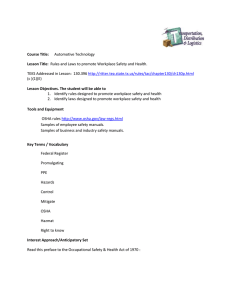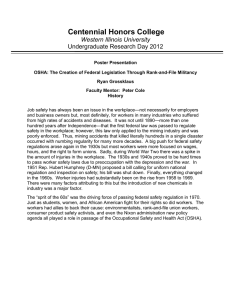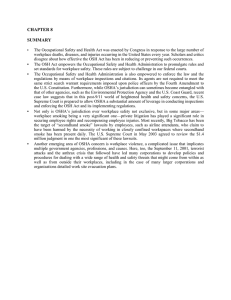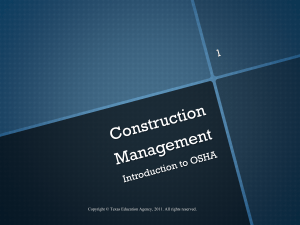WORKPLACE HEALTH AND SAFETY
advertisement
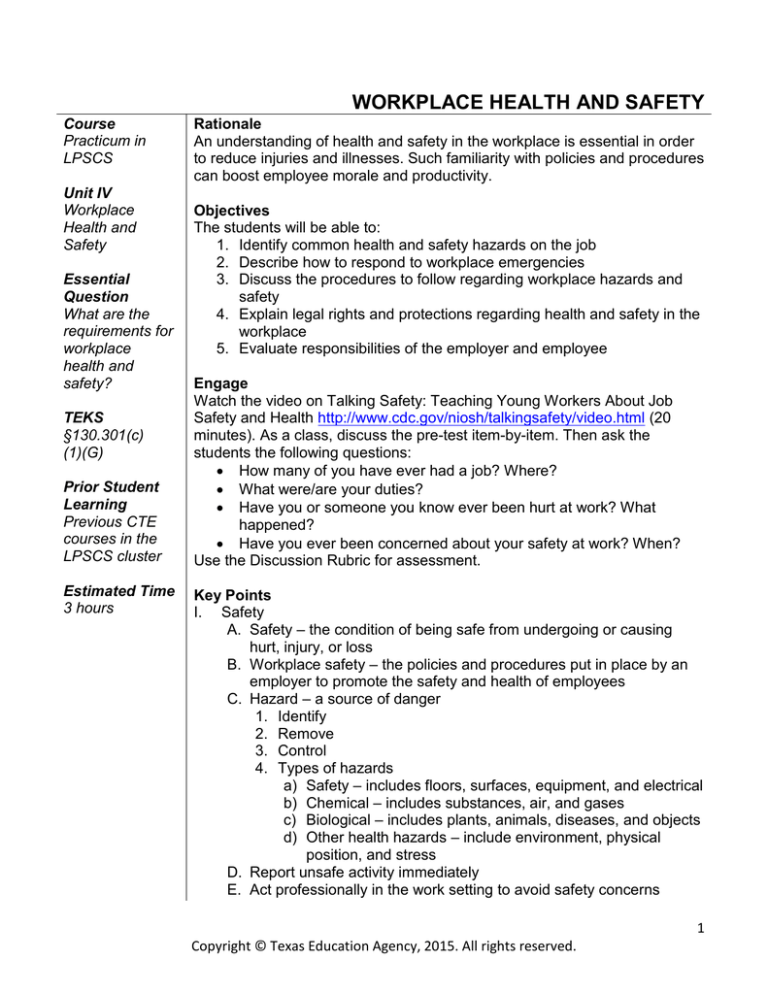
WORKPLACE HEALTH AND SAFETY Course Practicum in LPSCS Unit IV Workplace Health and Safety Essential Question What are the requirements for workplace health and safety? TEKS §130.301(c) (1)(G) Prior Student Learning Previous CTE courses in the LPSCS cluster Estimated Time 3 hours Rationale An understanding of health and safety in the workplace is essential in order to reduce injuries and illnesses. Such familiarity with policies and procedures can boost employee morale and productivity. Objectives The students will be able to: 1. Identify common health and safety hazards on the job 2. Describe how to respond to workplace emergencies 3. Discuss the procedures to follow regarding workplace hazards and safety 4. Explain legal rights and protections regarding health and safety in the workplace 5. Evaluate responsibilities of the employer and employee Engage Watch the video on Talking Safety: Teaching Young Workers About Job Safety and Health http://www.cdc.gov/niosh/talkingsafety/video.html (20 minutes). As a class, discuss the pre-test item-by-item. Then ask the students the following questions: How many of you have ever had a job? Where? What were/are your duties? Have you or someone you know ever been hurt at work? What happened? Have you ever been concerned about your safety at work? When? Use the Discussion Rubric for assessment. Key Points I. Safety A. Safety – the condition of being safe from undergoing or causing hurt, injury, or loss B. Workplace safety – the policies and procedures put in place by an employer to promote the safety and health of employees C. Hazard – a source of danger 1. Identify 2. Remove 3. Control 4. Types of hazards a) Safety – includes floors, surfaces, equipment, and electrical b) Chemical – includes substances, air, and gases c) Biological – includes plants, animals, diseases, and objects d) Other health hazards – include environment, physical position, and stress D. Report unsafe activity immediately E. Act professionally in the work setting to avoid safety concerns 1 Copyright © Texas Education Agency, 2015. All rights reserved. F. Statistics – 4,609 workers were killed on the job in 2011 (13 each day) (OSHA, 2011) II. Possible Causes of Workplace Accidents and Injuries A. Improper training B. Health or physical limitations C. Failure to identify hazardous conditions D. Substance abuse III. Occupational and Safety Health Administration (OSHA) A. Occupational Safety and Health Act passed in 1970 1. Requires employers to follow OSHA standards 2. Workplaces must be free from recognized hazards 3. Protects workers by enforcing OSHA standards B. Provides information C. Trains workers and employers D. Assists workers and employers E. 1-800-321-OSHA or www.osha.gov IV. Employer Duties under OSHA A. Must provide safety training B. Must provide a workplace that is free from hazards C. Must provide personal protective equipment, if needed D. Must comply with all of the OSHA standards, rules, and regulations E. Must keep records V. Employee Responsibilities under OSHA A. Must know employer’s policies and procedures B. Must comply with the OSHA standards and regulations C. Must know to whom safety issues must be reported VI. Employee’s Rights A. Labor Laws (http://www.osha.gov/workers.html) 1. Minimum age for some duties 2. Regulations on the number of hours and time of day minors can work B. Cannot be fired or punished for reporting a safety violation VII. Handling Workplace Health and Safety Problems A. Identify the problem B. Report the problem to a supervisor C. If nothing is done, contact an outside agency VIII. Emergency Action Plans (EAP) A. What is an emergency at work? 1. A sudden, urgent, usually unexpected event 2. Requires immediate attention 3. Could harm employees, customers, or the public 2 Copyright © Texas Education Agency, 2015. All rights reserved. 4. Might shut down business operations B. What should EAP cover? 1. What to do in different types of emergencies a) Weather emergency b) Fire emergency c) Evacuation emergency 2. Where to go a) Shelters b) Meeting places 3. Evacuation routes 4. Who is the designated “person in charge” 5. Proper procedures in case of injury C. Practice Drills D. Employee training regarding EAP Activities 1. Create a “Find the Hazards” Workplace Safety Poster. Divide the class into groups of 3-5 students. Have each group work together to create a poster for a specified LPSCS work environment (courtroom, correction facility, patrol car, firehouse, office, dispatch room, etc.). Have the students draw a scenario, depicting intentional health and safety hazards. Have the students present the poster to the class and list the hazards depicted in it. Use the Presentation Rubric for assessment. 2. Develop an EAP. Have students research emergency action plans on the Internet. Have each student choose five disastrous events and write a hypothetical EAP addressing each type of event for the workplace. The EAPs should include what the employer should do to keep employees safe, what the employees should be asked to do, and what the evacuation plans would be (examples of events could include weather, medical, evacuation due to a bomb threat, intruders, fire, power outages, etc.). EAPs should include maps. Use the Individual Work Rubric for assessment. Assessments Workplace Health and Safety Exam and Key Discussion Rubric Individual Work Rubric Presentation Rubric Research Rubric Materials Workplace Health and Safety computer-based presentation Workplace Health and Safety Key Terms Poster board Markers/colors Computers with Internet access 3 Copyright © Texas Education Agency, 2015. All rights reserved. Resources http://www.cdc.gov/niosh/ http://www.osha.gov/ Do an Internet search of definitions Accommodations for Learning Differences For reinforcement, the student will define and illustrate key terms in a journal. Use the Individual Work Rubric for assessment. For enrichment, the student will write a research paper about OSHA. The information should include the history of OSHA, specific employment areas of concern, statistics regarding injuries and accidents, and recent cases of OSHA violations. Use the Research Rubric for assessment. State Education Standards Texas Essential Knowledge and Skills for Career and Technical Education §130.301. Practicum in Law, Public Safety, Corrections, and Security (Two to Three Credits). (1) The student demonstrates professional standards as required by business and industry. The student is expected to: (G) comply with practicum setting safety rules and regulations to maintain safe and healthful working conditions and environments. College and Career Readiness Standards English/Language Arts Standards I. Writing A. Compose a variety of texts that demonstrate clear focus, the logical development of ideas in well-organized paragraphs, and the use of appropriate language that advances the author’s purpose. 1. Determine effective approaches, forms, and rhetorical techniques that demonstrate understanding of the writer’s purpose and audience. 2. Generate ideas and gather information relevant to the topic and purpose, keeping careful records of outside sources. 4 Copyright © Texas Education Agency, 2015. All rights reserved. WORKPLACE HEALTH AND SAFETY KEY TERMS 1. Safety – the condition of being safe from undergoing or causing hurt, injury, or loss 2. Hazard – a source of danger 3. Occupational and Safety Health Administration – “OSHA” provides information, trains workers/employers, and assists workers/employers on workplace health and safety conditions 4. Occupational Safety and Health Act – passed in 1970 to govern workplace health and safety in the private sector 5. Employee’s Rights – laws, regulations, policies, and procedures in place to protect employees 6. Emergency – a sudden, urgent, usually unexpected event which requires immediate attention 7. Emergency Action Plan – must be in writing, kept at the workplace, and available for employees to review. The purpose of an EAP is to facilitate and organize what actions should take place among employees and employers during an emergency at work 5 Copyright © Texas Education Agency, 2015. All rights reserved. WORKPLACE HEALTH AND SAFETY EXAM Name: _____1. Date: _____ ____ When was the Occupational Safety and Health Act passed? a. 1960 b. 1970 c. Neither a or b d. None of the above _____2. The Occupational Safety and Health Act does all of the following except a. Protect the employers from safety hazards b. Protect the workers by enforcing OSHA standards c. Require the employers to follow OSHA standards d. Require that workplaces be free from recognized hazards _____3. A hazard is a. The condition of being safe from undergoing or causing hurt, injury, or loss b. A law regarding employer responsibilities at work c. A source of danger d. An OSHA regulation _____4. Causes of workplace accidents and injuries include a. Substance abuse b. Improper training c. Physical limitations d. All of the above _____5. Employees should report safety violations to their supervisors. If a report is ignored, the employee can do the following without fear of retaliation: a. Report to an outside agency b. Contact the local news c. Yell at the supervisor d. None of the above _____6. OSHA a. Trains employers and employees about workplace health and safety b. Provides information about workplace health and safety to employers c. Assists employers and employees regarding OSHA violations d. All of the above _____7. Labor laws include regulations regarding a. The minimum age of an employee for certain duties b. The maximum number of hours a minor may work c. Both a and b d. The parental permission for employment of an employee under the age of 18 6 Copyright © Texas Education Agency, 2015. All rights reserved. _____8. An employer’s duties under OSHA include a. Taking no action regarding safety hazards b. Providing minors with the maximum amount of work hours c. Keeping records of employee training and safety violation reports d. Firing employees who make reports regarding safety violations _____9. An employee’s duties under OSHA include all the following except a. Complying with OSHA standards and regulations b. Knowing the employer’s policies and procedures c. Knowing to whom safety issues must be reported d. Providing his or her own personal protective equipment, if needed _____10. An emergency at work a. Could shut down business operations b. Should be ignored c. Is usually an expected event d. Never requires immediate attention _____11. An emergency action plan should include a. An evacuation route b. Where to go for shelter during a tornado warning c. Proper procedures if an injury occurs at work d. All of the above _____12. At work, it is important to perform a. Practice drills as established by the EAP b. Tornado warnings c. Biological hazards d. Disease reduction _____13. It is a violation of OSHA standards if workplaces are not free from a. Sick employees b. Young children c. Recognizable hazards d. Supervisors _____14. Weather emergencies include a. Fog b. Freezing rain c. Wind d. Tornado _____15. Biological hazards include a. Natural gas leak b. Poison ivy c. Wet floor d. Faulty equipment 7 Copyright © Texas Education Agency, 2015. All rights reserved. WORKPLACE HEALTH AND SAFETY EXAM KEY 1. b 2. a 3. c 4. d 5. a 6. d 7. c 8. c 9. d 10. a 11. d 12. a 13. c 14. d 15. b 8 Copyright © Texas Education Agency, 2015. All rights reserved. Name_______________________________________ Date_______________________________ Discussion Rubric 4 pts. Excellent Objectives 3 pts. Good 2 pts. Needs Some Improvement 1 pt. Needs Much Improvement N/A Pts. Participates in group discussion Encourages others to join the conversation Keeps the discussion progressing to achieve goals Shares thoughts actively while offering helpful recommendations to others Gives credit to others for their ideas Respects the opinions of others Involves others by asking questions or requesting input Expresses thoughts and ideas clearly and effectively Total Points (32 pts.) Comments: 9 Copyright © Texas Education Agency, 2015. All rights reserved. Name______________________________________ Date_______________________________________ Individual Work Rubric 4 pts. Excellent Objectives 3 pts. Good 2 pts. Needs Some Improvement 1 pt. Needs Much Improvement N/A Pts. Follows directions Student completed the work as directed, following the directions given, in order and to the level of quality indicated Time management Student used time wisely and remained on task 100% of the time Organization Student kept notes and materials in a neat, legible, and organized manner. Information was readily retrieved Evidence of learning Student documented information in his or her own words and can accurately answer questions related to the information retrieved *Research/Gathering information (if relevant) Student used a variety of methods and sources to gather information. Student took notes while gathering information Total Points (20 pts.) Comments: 10 Copyright © Texas Education Agency, 2015. All rights reserved. Name:____________________________________ Date:_____________________________ Presentation Rubric 4 pts. Excellent Objectives 3 pts. Good 2 pts. Needs Some Improvement 1 pt. Needs Much Improvement N/A Pts. Topic/Content Topic discussed completely and in-depth Includes properly cited sources (if used) Creativity/Neatness Integrates a variety of multimedia effects to create a professional presentation (transition and graphics) or appropriate visual aid used Title slide, table of contents, bibliography are included, using acceptable format Mechanics Grammar, spelling, punctuation, and capitalization are correct Image and font size are legible to the entire audience Oral Presentation Communicates with enthusiasm and eye contact Voice delivery and projection are dynamic and audible Audience Interaction Presentation holds audience’s attention and relates a clear message Clearly and effectively communicates the content throughout the presentation Total Points (20 pts.) Comments: 11 Copyright © Texas Education Agency, 2015. All rights reserved. Name______________________________________ Date_______________________________________ Research Rubric 4 pts. Excellent Objectives 3 pts. Good 2 pts. Needs Some Improvement 1 pt. Needs Much Improvement N/A Pts. Question/goal Student identified and communicated a question or goal of the research Research/Gathering information (if relevant) Student used a variety of methods and sources to gather information. Student took notes while gathering information Conclusion/Summary Student drew insightful conclusions and observations from the information gathered. Information is organized in a logical manner Communication Student communicated the information gathered and summary or conclusions persuasively. Student demonstrated skill in the use of media used to communicate the results of research Reflection Student reflected on the importance of the research and its potential application Total Points (20 pts.) Comments: 12 Copyright © Texas Education Agency, 2015. All rights reserved.
